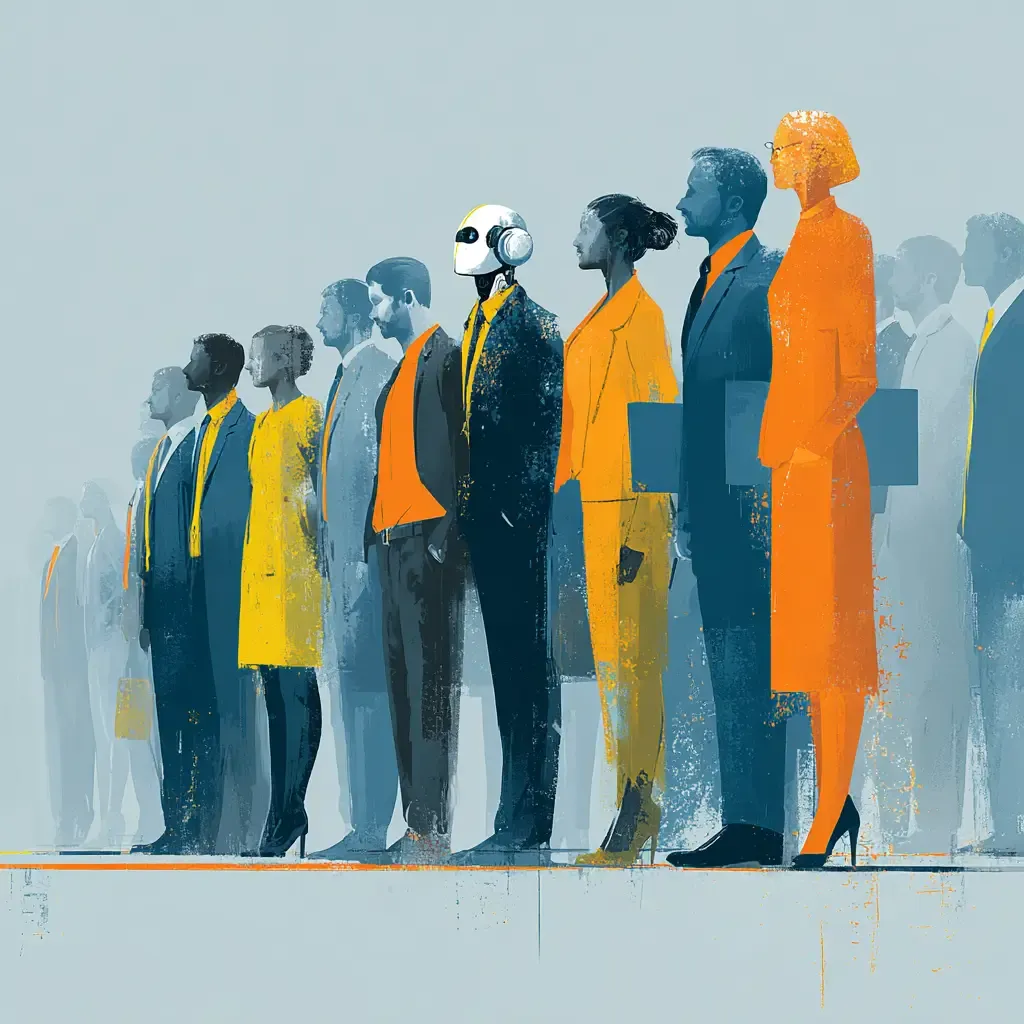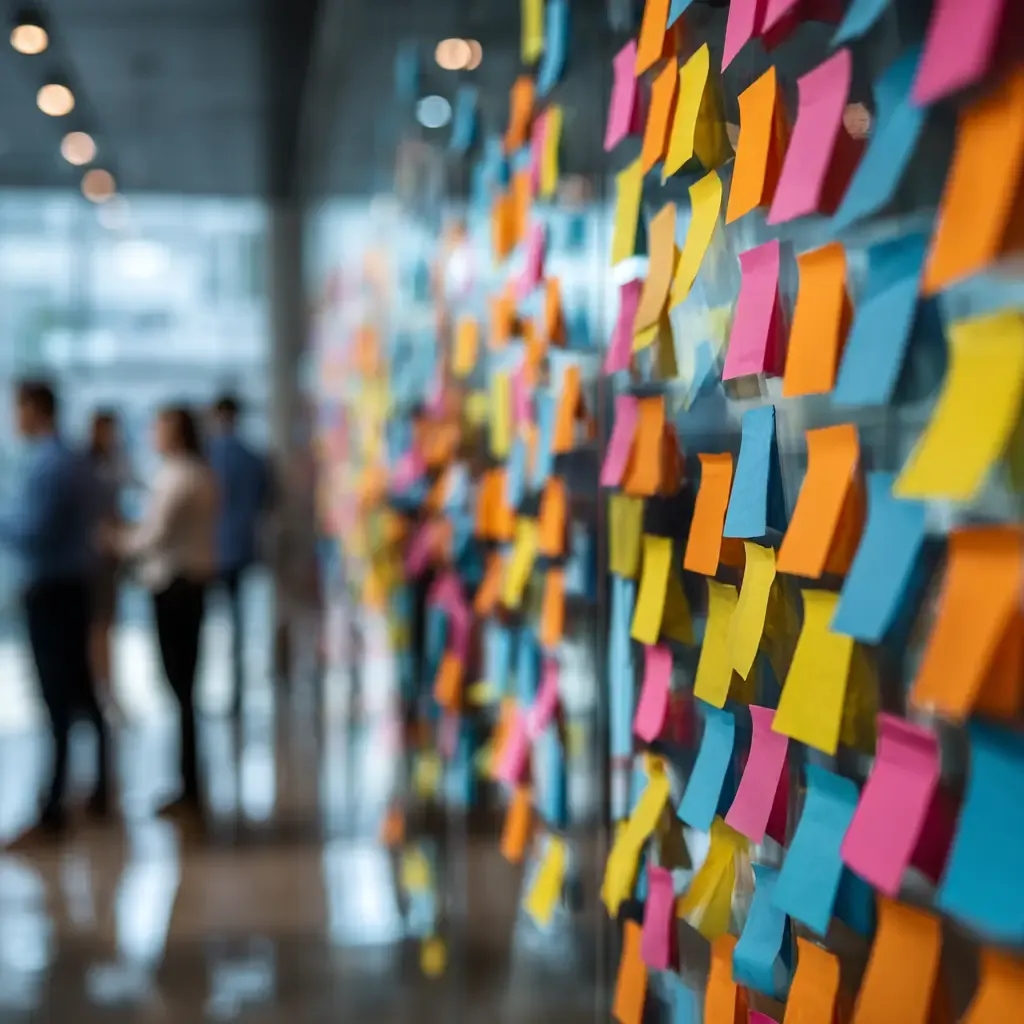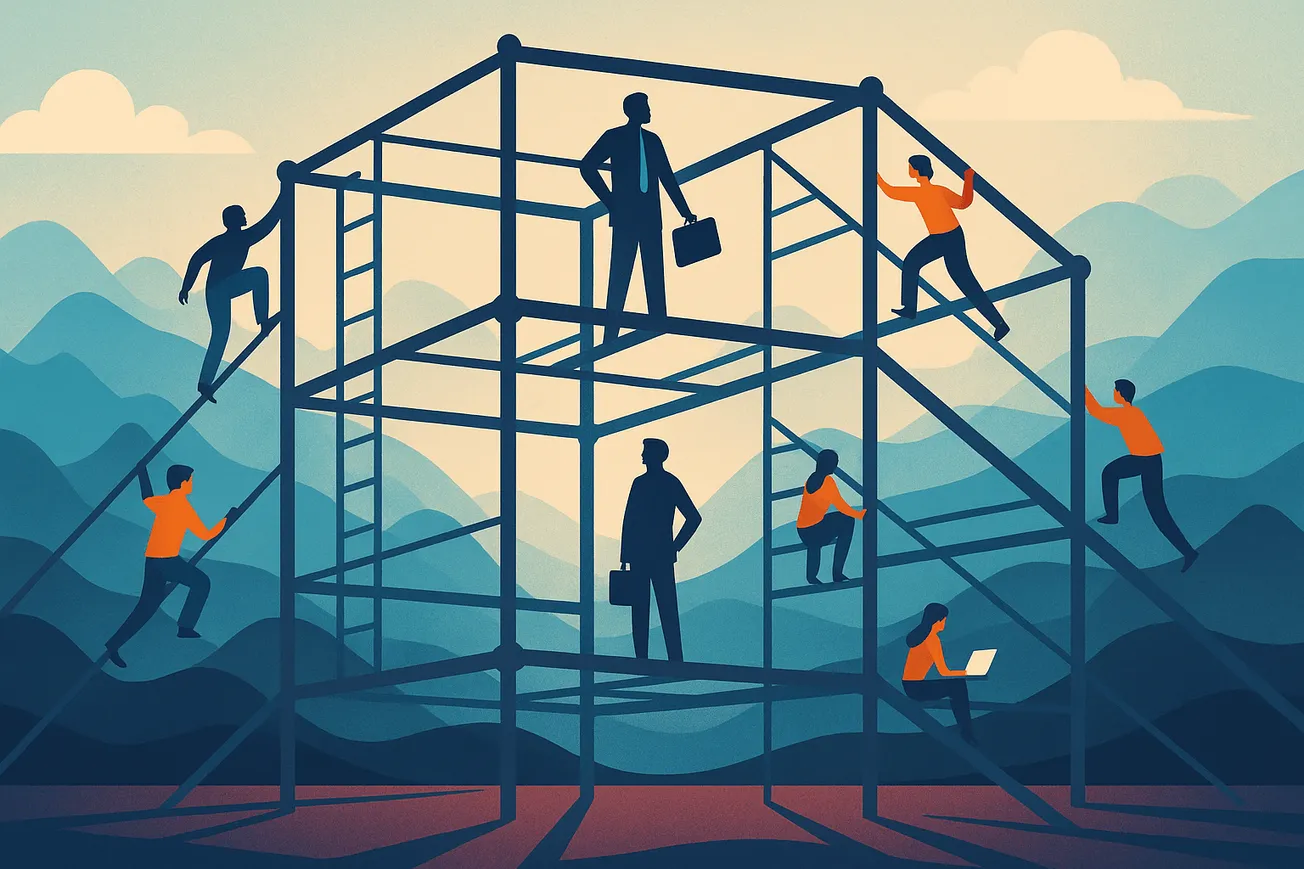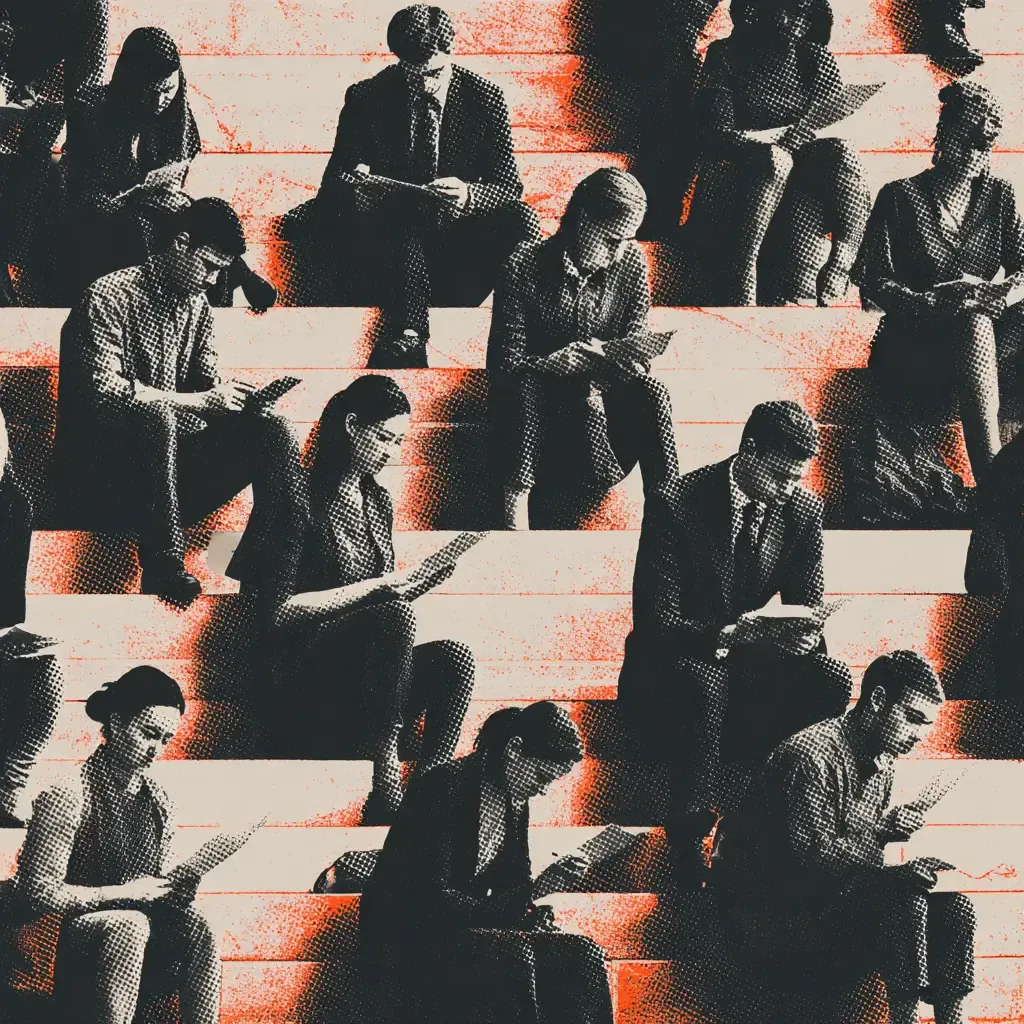A GuildCraft Deep Dive
How the Role of the Practitioner Evolves with AI
TL;DR: AI is automating the repetitive, data-heavy parts of change work—drafting messages, segmenting stakeholders, analyzing feedback, and tracking adoption. This doesn’t replace change practitioners; it reshapes the role. The value shifts from producing deliverables to guiding meaning, alignment, and culture. To prepare, focus on AI literacy, better data foundations, small pilots, and clear guardrails that keep the work human-centered.
1. The Future Just Clocked In
Picture this: it’s 2030.
You walk into your virtual change office, and the dashboards are already humming. One AI agent has flagged that adoption in Field Operations is trending five points below forecast. Another has drafted three versions of a message to the regional leads—each tailored to their tone profiles and upcoming workload. A third is running a simulation of how a proposed policy shift will ripple through your stakeholder network.
You haven’t done a thing yet. But the work of change has already begun.
This isn’t a sci-fi fantasy. It’s a plausible future that is already visible at the edge of our profession. The systems are here—process-mining engines, generative language models, digital adoption platforms, and sentiment analyzers—and they’re converging faster than most organizations can keep up. Within five years, “the change office” will look less like a war room full of sticky notes and more like a control room staffed by hybrid teams of humans and algorithms.
The good news: none of this replaces the human art of change. It reframes it.
What follows is a roadmap for practitioners who want to thrive in the age of AI-first change.
2. From Tools to Teammates
Every discipline has its automation moment. Finance had spreadsheets, marketing had CRM, and operations had ERP. Change management’s moment is now arriving through AI.
Over the past two years, McKinsey, MIT, and the World Economic Forum have all converged on a common signal: roughly a third of all work hours could be automated by 2030, especially in information-heavy roles. That doesn’t mean jobs vanish. It means workflows shift, with humans spending less time producing artifacts and more time interpreting, sense-making, and designing interventions.
In practice, the “AI teammate” model means that what we call change work will increasingly be done with intelligent systems that:
- Draft content, campaigns, and leader messages.
- Segment audiences based on data signals.
- Analyze feedback and process data to anticipate impacts.
- Track adoption through telemetry and predictive analytics.
Each of these areas is already seeing tangible gains. Let’s explore them in turn.
3. The Four Domains of AI-Inflected Change Work
3.1 Drafting and Content Generation
Generative AI is already redefining how we communicate. In controlled experiments, professionals who used large language models to draft business writing produced higher-quality work in less time. For change teams, this doesn’t just mean faster message turnaround; it changes the economics of clarity.
An AI-assisted writer can:
- Produce multiple tone variants for a single message (executive brief, field email, social post).
- Rewrite content for specific literacy or cultural contexts.
- Keep message libraries consistent across hundreds of deliverables.
Imagine a utility company rolling out a new billing system. Instead of writing every communication from scratch, the change team feeds templates, stakeholder personas, and policy constraints into an AI model. The system drafts, tags, and versions all communications automatically—ready for human review.
Cycle time drops by half. Quality goes up. The human focus shifts from writing words to curating meaning.
The caveat: speed doesn’t equal sense. AI can mimic style but still miss tone, nuance, or organizational politics. Human oversight remains the final guardrail of credibility.
3.2 Stakeholder Segmentation and Targeting
If communications are the message, segmentation is the match. AI excels at finding patterns in messy data—usage logs, survey responses, meeting attendance, network graphs—and clustering stakeholders by behavioral signals rather than job titles.
This is where change management starts borrowing from marketing. The same recommendation engines that power customer personalization now help change teams design next-best experiences: nudges, messages, or interventions tailored to where a person actually is on their adoption journey.
A software company implementing a new CRM system can now feed engagement data from pilot sites into an AI clustering model. The system identifies three behavioral cohorts:
- Champions — using the tool deeply and evangelizing it.
- Fence-sitters — sporadic log-ins, neutral sentiment.
- Skeptics — low adoption, high complaint ratio.
The AI doesn’t just label these groups—it suggests differentiated strategies: recognition for Champions, quick-win tutorials for Fence-sitters, one-on-one support for Skeptics.
What used to take weeks of survey analysis can now happen daily. But, again, the practitioner’s judgment is indispensable: data without empathy becomes manipulation.
3.3 Change Impact Analysis and Sensing
If change management had an unglamorous hero, it would be the impact analysis spreadsheet—massive, manual, and instantly outdated. AI is about to retire it.
Modern process-mining tools can ingest system logs and reconstruct how work actually happens—every queue, rework loop, and handoff. When paired with AI-based org-network analysis, they can also reveal how influence and information truly flow. Together, these offer a live X-ray of the organization.
In a large-scale ERP rollout, for instance, an AI system can map all workflows touched by a new billing process, flag the roles most affected, and even predict where resistance will spike based on historical change sentiment.
Layer on an LLM trained to summarize open-ended survey feedback, and the result is a living impact model that evolves as the project evolves.
This doesn’t just save time—it transforms timing. Impact analysis becomes continuous, not episodic. Practitioners can detect emerging risks and address them before they become crises.
The trade-off is interpretability: AI can tell you what changed, not necessarily why it matters. Human facilitation—contextual inquiry, sense-making, storytelling—remains the bridge between data and meaning.
3.4 Adoption Tracking and Telemetry
The final frontier is visibility. Traditional adoption measurement relies on lagging indicators—training attendance, survey scores, or anecdotal feedback. By the time you know adoption is off track, the damage is done.
AI turns that on its head through real-time telemetry. Digital adoption platforms (DAPs) and in-app guidance systems already log user interactions, flag drop-offs, and trigger automated nudges. When coupled with predictive analytics, they can forecast where adoption is likely to stall.
In one energy company, AI monitored usage of a new field-work app. When a cluster of crews stopped using a safety feature, the system sent personalized reminders and alerted supervisors. Usage rebounded within a week.
This creates a feedback loop: behavior → insight → targeted intervention → new behavior.
The practitioner’s role? Interpret and narrate the story behind the data. What looks like resistance might actually be a workflow design flaw or an incentive misalignment. AI surfaces the pattern; humans assign the meaning.
4. The Human Shift: From Deliverables to Direction
If AI handles the tactical execution, what’s left for humans?
Plenty—and arguably, the parts that matter most.
Interpretation. Turning raw data into insight and insight into story.
Facilitation. Creating shared understanding across silos that machines can’t traverse.
Design. Deciding not just what will change, but how people will experience that change.
Ethics. Ensuring fairness, transparency, and humanity in algorithmic decisions.
Culture. Modeling curiosity, empathy, and adaptability—the traits machines can’t fake.
In short, AI automates the work of change, freeing practitioners to elevate the art of change.
But this shift doesn’t happen by default. It demands readiness.
5. Building Readiness for an AI-First Change Function
5.1 Data Foundation and Instrumentation
Every AI system feeds on data. If your org’s adoption data lives in a dozen spreadsheets, you’re not ready.
Start by auditing what data you already capture—system logs, survey results, training attendance, sentiment feeds—and establish clean, consistent pipelines.
Data is to AI what empathy is to change: without it, everything else is guesswork.
5.2 Pilot, Don’t Preach
Treat AI like any other transformation: experiment, measure, learn.
Run small pilots in low-risk areas—FAQ drafting, sentiment analysis, or change heatmaps. Track outcomes in time saved, message quality, or adoption rates.
Pilots demystify AI and surface both technical and cultural friction early.
5.3 Upskill for AI Literacy
Tomorrow’s change professional needs to be as comfortable writing prompts as writing comms plans.
Invest in team learning around:
- Generative AI basics
- Prompt design and verification
- Data storytelling and visualization
- Ethics and bias awareness
Think of it as adding a new language to your professional toolkit—the language of systems that learn.
5.4 Governance and Guardrails
Speed without structure is chaos. Define rules for AI use early:
- Which tasks can be automated, and which must remain human-led?
- How are AI outputs reviewed and approved?
- What data sources are off-limits or sensitive?
- How will you disclose AI-authored content to stakeholders?
Clarity builds confidence. Transparency builds trust.
5.5 Human-Centered Change Design
Finally, double down on the human side. As automation grows, empathy becomes a competitive advantage.
Use AI to see patterns, not to dictate them. Reconnect insights to the lived experience of employees, customers, and partners.
In an age of algorithms, humanity is the ultimate differentiator.
6. The Hybrid Model: Humans and Machines at Work
The future isn’t AI replacing practitioners—it’s practitioners orchestrating AI.
Imagine the change team of 2030:
- An Impact Analyst AI continuously models who’s affected by upcoming initiatives.
- A Communications AI drafts messages in multiple formats and tones.
- A Behavioral AI monitors telemetry and triggers targeted interventions.
- A Meta-Manager AI coordinates these agents, ensuring alignment and compliance.
The human team leads strategy, ethics, and storytelling—deciding where to focus attention, what story to tell, and when to pause the machines to listen.
This is the new muscle memory: working in co-production with intelligent systems. The goal isn’t efficiency alone; it’s precision, foresight, and inclusion.
Machines can help you reach everyone—but only humans can ensure everyone feels seen.
7. The Long Arc: How the Practitioner Role Evolves
Between now and 2030, expect three identity shifts:
- From Planner to Pattern-Finder. Less time building Gantt charts, more time interpreting patterns from AI dashboards and data models.
- From Communicator to Curator. Editing AI-drafted narratives, ensuring tone, truth, and resonance.
- From Manager to Ethicist. Guiding responsible use of automation within change programs.
In a sense, this is a return to the discipline’s roots: change management began as a human science, not a document factory. AI brings us full circle—removing the mechanical work so we can refocus on meaning, context, and connection.
8. Final Thought: The New Covenant of Change
The promise of AI-first change isn’t that the machines will manage transformation for us. It’s that they will surface what we often miss—hidden networks, quiet resistance, faint signals of fatigue—and give us the time and insight to respond.
If we treat AI as a partner rather than a threat, the work of change could become more evidence-based, more inclusive, and more humane.
But that depends on practitioners who are willing to evolve—those who learn to read both the human story and the machine’s data in the same breath.
The future change office will not be built by engineers alone. It will be led by the same kind of people who have always guided transformation: curious, empathetic, systems-minded humans who understand that technology doesn’t change organizations—people do.
Our job is to make sure both sides of that equation grow together.
ChangeGuild: Power to the Practitioner™
Frequently Asked Questions
Is AI going to replace change practitioners?
No. AI handles analysis, drafting, and monitoring. Humans still do the relational work: sense-making, alignment, facilitation, coaching, and culture-shaping.
What parts of change work are most affected by AI?
Four areas are already shifting:
1. Drafting communications
2. Stakeholder segmentation
3. Impact analysis
4. Adoption tracking and telemetry
What skills matter most going forward?
AI literacy, data interpretation, facilitation, and narrative design. The value shifts from producing deliverables to guiding understanding and action.
Do we need new tools to start?
Not necessarily. Start by using the tools you already have differently—especially data you’re already collecting.
How do we experiment safely?
Run small pilots with human review. Measure time saved, clarity gains, or adoption lift. Treat pilots as learning loops, not automation mandates.
What’s the role of the practitioner in an AI-enabled change office?
To interpret the signals, design the experience, protect trust, and ensure the technology serves humans—not the other way around.






